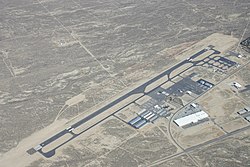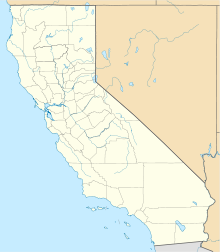General William J. Fox Airfield
General Wm. J. Fox Airfield | |||||||||||
|---|---|---|---|---|---|---|---|---|---|---|---|
 Fox Field (February 2008) | |||||||||||
| Summary | |||||||||||
| Airport type | Public | ||||||||||
| Owner | County of Los Angeles | ||||||||||
| Serves | Lancaster, California | ||||||||||
| Elevation AMSL | 2,351 ft / 717 m | ||||||||||
| Coordinates | 34°44′28″N 118°13′07″W / 34.74111°N 118.21861°W | ||||||||||
| Map | |||||||||||
| Runways | |||||||||||
| |||||||||||
| Statistics (2021) | |||||||||||
| |||||||||||
General William J. Fox Airfield (IATA: WJF, ICAO: KWJF, FAA LID: WJF) is a county-owned, public airport in Los Angeles County, California,[1] five miles northwest of Lancaster, California, United States.[1] Locally known as Fox Field, the airport serves the Antelope Valley. The airport is named after Brigadier General William J. Fox, "a Marine war hero, a movie stunt man, the first Los Angeles County engineer and, for 20 years after his retirement, a cowboy."[2]
The National Plan of Integrated Airport Systems for 2011–2015 categorized it as a general aviation facility.[3] The airport has limited scheduled cargo operations. The U.S. Forest Service has a fixed wing airtanker and helicopter base on the airfield which becomes one of the main hubs in the region for aerial firefighting suppression efforts during fire season.
Historical airline service
[edit]Fox Field had scheduled passenger air service as early as the late 1950s operated by Southwest Airways with Douglas DC-3 aircraft primarily to the Los Angeles International Airport (LAX).[4] Southwest Airways then changed its name to Pacific Air Lines which in 1959 was operating new Fairchild F-27 turboprops from the airport nonstop to Las Vegas and also to Burbank Airport (BUR, now Hollywood Burbank Airport) on a daily basis as well as operating Martin 4-0-4 and DC-3 prop aircraft on flights to LAX.[5] By 1960, Pacific was operating daily F-27 propjet flights to San Francisco (SFO) from Fox Field via a stop in Bakersfield and also nonstop to LAX.[6] In 1968, Pacific Air Lines merged with Bonanza Air Lines and West Coast Airlines to form Air West which in turn continued to serve the airport with F-27 flights to LAX.[7] Also in 1968, Cable Commuter Airlines was operating de Havilland Canada DHC-6 Twin Otter service to LAX.[8] Air West then changed its name to Hughes Airwest which continued to operate scheduled passenger service with the Fairchild F-27 turboprop primarily to Los Angeles International Airport during the early 1970s with several nonstop flights a day.[9] By 1983, Mojave Airlines was operating flights to LAX, San Diego, Ontario and Mammoth Yosemite Airport with Beechcraft C99 turboprops.[10] In 1985, commuter air carrier Desert Sun Airlines was operating up to five flights a day nonstop to LAX with Beechcraft 99 turboprops.[11]
Fox Field currently does not have any scheduled passenger flights, with the nearest airline service being available at the Bob Hope Airport in Burbank.
Facilities
[edit]General William J. Fox Airfield covers 1,217 acres (493 ha) at an elevation of 2,351 feet (717 m) above sea level. Its one runway, 6/24, is 7,201 by 150 feet (2,195 x 46 m) asphalt.[1]
In the year ending December 31, 2021, the airport had 48,184 aircraft operations, average 132 per day: 97% general aviation, 3% military, and 1% air taxi. 60 aircraft were then based at this airport: 56 single-engine, 2 multi-engine, and 2 glider.[1]
Airlines and destinations
[edit]Cargo
[edit]| Airlines | Destinations |
|---|---|
| Ameriflight | Ontario |
Accidents and incidents
[edit]- On October 17, 1978, a Learjet 24 owned by Martin Aviation cartwheeled during takeoff which was part of a touch and go. Out of two occupants on board, one died.[12]
References
[edit]- ^ a b c d e FAA Airport Form 5010 for WJF PDF. Federal Aviation Administration. Effective July 11, 2024.
- ^ "William J. Fox, 95, a War Hero, Engineer, Stunt Man and Cowboy". obituary. New York Times. April 17, 1993. Retrieved March 19, 2021.
- ^ "2011–2015 NPIAS Report, Appendix A" (PDF). National Plan of Integrated Airport Systems. Federal Aviation Administration. October 4, 2010. Archived from the original (PDF, 2.03 MB) on 2012-09-27.
- ^ http://www.timetableimages.com, April 28, 1957 Southwest Airways system timetable
- ^ http://www.timertableimages.com, July 1, 1959 Pacific Air Lines system timetable
- ^ http://www.timetableimages.com, April 24, 1960 Pacific Air Lines system timetable
- ^ http://www.timetableimages.com, July 1, 1968 Air West system timetable
- ^ http://www.timetableimages.com, Dec. 1, 1968 Cable Commuter Airlines system timetable
- ^ http://www.departedflights.com, July 1, 1972 Hughes Airwest system timetable
- ^ http://www.timetableimages.com, 1983 Mojave Airlines timetable
- ^ http://www.departedflights.com, Feb. 15, 1985 Official Airline Guide (OAG), LAX schedules
- ^ "Accident description for N123RE at Aviation Safety Network". aviation-safety.net. Retrieved July 15, 2024.
External links
[edit]- Aerial image from USGS The National Map
- FAA Airport Diagram (PDF), effective August 8, 2024
- FAA Terminal Procedures for WJF, effective August 8, 2024
- Resources for this airport:
- FAA airport information for WJF
- AirNav airport information for KWJF
- ASN accident history for WJF
- FlightAware airport information and live flight tracker
- NOAA/NWS weather observations: current, past three days
- SkyVector aeronautical chart, Terminal Procedures

